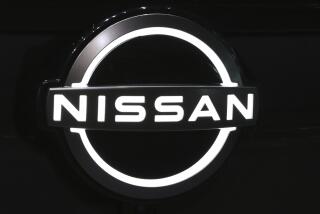What’s Smart? Seating Children in the Back
- Share via
Just how intelligent are Ford Motor Co.’s new “smart” air bags?
Apparently not brainy enough to justify placing your infant or small child in the front passenger seat.
Despite the fanfare last week over Ford’s announcement of its advanced restraint system, the company’s top safety expert and a leading consumer safety advocate both say the back seat is still the safest place in the car for babies and young children.
At this point, “there is no known technology that would safely permit placing a rear-facing child seat in the front,” says Lou Camp, Ford’s director of automotive safety. “With or without air bags . . . the safest place for children is in the back seat.”
Janet Dewey, executive director of the National Safety Council’s air bag and seat belt safety campaign, agrees: “I still believe that buckled in the back is where children should be.”
Consider this, Dewey says: If you’re in a serious accident with two children in a car--one in the back and one in the front--the one buckled in the back has the greater chance of surviving the crash, advanced air bags or not.
The smart air bag design uses electronic sensors to control seat belt tension and how aggressively the bag deploys, factoring in the passenger’s weight, seat position and belt usage and the severity of the crash.
The push for such technology is in response to the alarming number of deaths and injuries to adults and children in the last decade. In the United States, 122 people--68 of them children--have been killed by air bags. Tragically, many of these deaths occurred during minor accidents in which injuries otherwise were unlikely to have resulted.
*
But if there’s still a risk to children--even with the new air bags--why bother with such a major investment in this technology? Though there’s no fail-safe way to eliminate the risk of injury during air bag deployment, Camp says, there’s no doubt that the smart air bag technology will minimize injuries to adults and children in the front seat.
“They will go a long way in reducing air bag injuries,” he says. Nevertheless, Camp concedes, “none of these devices are clairvoyant.”
The accuracy of the sensors depends on many variables, including the way someone is seated and how tight the belt is.
Ford is confident that the new bags will not deploy if the weight detected on the seat is 45 pounds or less. Thus the bags would probably not deploy if an infant in a child carrier were placed in the front seat. Still, to be safe, parents are advised to keep infants in the back seat.
Safety advocates are hopeful that the new air bags will not leave parents with a false sense of security. Dewey, for one, praises the technology but worries that complacent parents may wrongly believe it is now completely safe to place their infants or small children in the front passenger seat.
People who don’t buckle up or who place their babies in front of an air bag “believe they won’t be in a crash,” she says. “Their sense is ‘I’m not at risk.’ ”
“But kids are dying,” she says. “The bottom line is kids have to be properly restrained.”
*
The National Highway Traffic Safety Administration is expected to adopt new regulations this year requiring all auto makers to install smart air bag systems beginning in three years.
Although NHTSA welcomes the introduction of smart bags, spokesman Tim Hurd says, the back seat is still the safest place in the car, especially for youngsters.
As the first auto maker to commit to equipping vehicles with the system, Ford plans to begin offering the technology to consumers as early as this summer. Ford is expected to install the system in existing models, probably beginning with the 2000 Taurus mid-size sedan.
Camp insists that the cost of the advanced air bags will not be passed on to consumers.
Just how expensive the system is, Ford officials won’t say. But if we believe they aren’t going to add the cost to the sticker price, we have to believe that the company’s stockholders are willing to take a hit on profit. How likely will they be to stand for that, especially when U.S. auto makers first resisted the technology, complaining it was too difficult and too costly to make?
Jeanne Wright cannot answer mail personally but will attempt to respond in this column to automotive questions of general interest. Write to Your Wheels, Business Section, Los Angeles Times, Los Angeles, CA 90053. Via e-mail: highway1@latimes.com.






